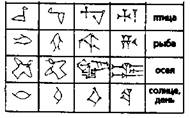home
 Economy Economy
 books books
 The history of the world economy - Polyak GB The history of the world economy - Polyak GB
|
The history of the world economy - Polyak GB
The science. Education
The growth of the productive forces of the country contributed to the development of science and education. Even in times of states of Sumer and Akkad around 3000 BC. e. It appeared in Mesopotamia cuneiform writing, which is a combination of the wedge-shaped dashes, extruded on tablets made of raw clay. First signs displayed the concrete objects, concepts, and then sound combinations, syllabic, phonetic values. This writing system spread throughout the Middle East and became the basis for the development of many modern alphabets: Aramaic (Hebrew, Arabic), Greek (Latin, Slavic-Kirillov, Georgian, Armenian).

Cuneiform
Household demand gave rise to the development of science, especially astronomy and mathematics. The economy was unthinkable without mathematical calculations of the number of products, labor, land plots. Mesopotamia has given the world the beginning of mathematics, first sexagesimal and then the decimal number system, raising to a power, extraction of square and cube roots, the principle of arithmetic and geometric progressions, arithmetic fractions, multiplication table, the first knowledge of geometry, algebra, quadratic equations. For arithmetic tools used - such as accounts. The Babylonian system of weights and measures passed to many ancient peoples.
The need to identify a person to find the area and establish time accounts contributed to the birth of astronomy. Priests were observing the stars and luminaries. These observations are first accumulated and passed down orally from generation to generation, and then after the appearance of writing began to be recorded in the form of scientific knowledge. At high temple tower ziggurat-creation of the first observatory in the world, where astronomical observations were carried out. The priests knew about the four countries of the world, knew five planets and their orbits. The starry sky was divided into 15 parts, and the stars spread across the constellations, defined 12 zodiacs. Astronomers have calculated that lunar eclipses occur within 6585 days, ie, they could predict eclipses. They founded astrology, predicting the fate of people.
Knowledge of astronomy allowed the priests to create a calendar system. Calendar units of steel a year, the lunar month, day. A year consisted of 365 days, divided into 12 parts - months. Astronomical knowledge of Mesopotamian priests went to many people. "Father of History", the Greek historian Herodotus wrote that the Greeks got a lot of knowledge of the Babylonians.
Geography as a science has developed in Mesopotamia. In the III millennium. BC. e. the inhabitants of this country have been known not only directions, but also the first maps made on clay tablets. Later on these cards was shown Babylon and neighboring countries.
Medicine, as a complex of knowledge, and as an independent profession, also originated in Mesopotamia. Around 2700 BC. e. in Babylon were surgeons, doctors who treated eye and other diseases. Doctors have described the symptoms of many diseases, including respiratory, gastrointestinal tract, rheumatism, diseases of the eye, kidney, and others. For the treatment of drug used, compresses, massage. Mesopotamian surgeons in the XVIII century. BC. e. were able to remove the cataract of the eye. The fact that it was the usual operation, shows King Hammurabi Code, which regulated payment of such an operation: the operation of the nobles doctor received 10 shekels, commoner - 5 NIS slave - 2 shekels. Thus, the law of economically stimulated the doctor to increase their responsibility in the commission of a surgical operation.
In Mesopotamia around 2000 BC. e. invented as a detergent and disinfectant soap. His brewed from vegetable oils and lye.
All this knowledge and technology have passed by inheritance to other people, however, as the emblem of medicine: a symbol of the god of medicine and doctors has been the patron Ninase snake scepter.
The knowledge acquired in schools at the temples. Then there are special state schools. The first such institution in the world was the school created around 2000 BC. e. Sumerian king Shulga. Here the youth studied writing, mathematics, languages, medicine, astronomy and astrology, translation from one language to another, theology, law, music.
The first library was also created in Mesopotamia in VII. BC. e. Ashshurbanipalom king, who collected religious and legislative materials from ancient times. To transfer them to the contemporary language first dictionaries were created. In this library, the first steps in computer science were made. Developed catalogs of clay tablets, performed their numbers at the end of each plate to make the text annotation, trained guides to quickly find the desired text.
Economy, science and culture of ancient Mesopotamia became the basis for the development of the Middle East, the Mediterranean and in the future the entire European civilization.
Review Questions
1. Think of where and when the first state.
2. Tell us about the formation of the first states premises.
3. Describe the land tenure system in ancient states. What are the most important crops grown in the states of the Ancient East.
4. What kinds of crafts have received the greatest development and why?
5. Tell us about the development of domestic and foreign trade.
6. What scientific knowledge industry first emerged in ancient states?


Comments
Commenting, keep in mind that the content and the tone of your messages can hurt the feelings of real people, show respect and tolerance to his interlocutors, even if you do not share their opinion, your behavior in terms of freedom of speech and anonymity offered by the Internet, is changing not only virtual, but real world. All comments are hidden from the index, spam control.